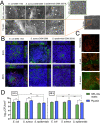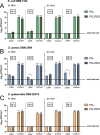Development of In Vitro and Ex Vivo Biofilm Models for the Assessment of Antibacterial Fibrous Electrospun Wound Dressings
- PMID: 36669095
- PMCID: PMC9907351
- DOI: 10.1021/acs.molpharmaceut.2c00902
Development of In Vitro and Ex Vivo Biofilm Models for the Assessment of Antibacterial Fibrous Electrospun Wound Dressings
Abstract
Increasing evidence suggests that the chronicity of wounds is associated with the presence of bacterial biofilms. Therefore, novel wound care products are being developed, which can inhibit biofilm formation and/or treat already formed biofilms. A lack of standardized assays for the analysis of such novel antibacterial drug delivery systems enhances the need for appropriate tools and models for their characterization. Herein, we demonstrate that optimized and biorelevant in vitro and ex vivo wound infection and biofilm models offer a convenient approach for the testing of novel antibacterial wound dressings for their antibacterial and antibiofilm properties, allowing one to obtain qualitative and quantitative results. The in vitro model was developed using an electrospun (ES) thermally crosslinked gelatin-glucose (GEL-Glu) matrix and an ex vivo wound infection model using pig ear skin. Wound pathogens were used for colonization and biofilm development on the GEL-Glu matrix or pig skin with superficial burn wounds. The in vitro model allowed us to obtain more reproducible results compared with the ex vivo model, whereas the ex vivo model had the advantage that several pathogens preferred to form a biofilm on pig skin compared with the GEL-Glu matrix. The in vitro model functioned poorly for Staphylococcus epidermidis biofilm formation, but it worked well for Escherichia coli and Staphylococcus aureus, which were able to use the GEL-Glu matrix as a nutrient source and not only as a surface for biofilm growth. On the other hand, all tested pathogens were equally able to produce a biofilm on the surface of pig skin. The developed biofilm models enabled us to compare different ES dressings [pristine and chloramphenicol-loaded polycaprolactone (PCL) and PCL-poly(ethylene oxide) (PEO) (PCL/PEO) dressings] and understand their biofilm inhibition and treatment properties on various pathogens. Furthermore, we show that biofilms were formed on the wound surface as well as on a wound dressing, indicating that the demonstrated methods mimic well the in vivo situation. Colony forming unit (CFU) counting and live biofilm matrix as well as bacterial DNA staining together with microscopic imaging were performed for biofilm quantification and visualization, respectively. The results showed that both wound biofilm models (in vitro and ex vivo) enabled the evaluation of the desired antibiofilm properties, thus facilitating the design and development of more effective wound care products and screening of various formulations and active substances.
Keywords: antibacterial; antibiofilm; electrospinning; ex vivo biofilm model; in vitro biofilm model; skin wound infection; wound dressings.
Conflict of interest statement
The authors declare no competing financial interest.
Figures







Similar articles
-
Development of Rapid and Economic In Vitro Assay and Biorelevant Ex Vivo Biofilm Inhibition Wound Model to Test the Antibacterial Efficacy of Wound Dressings.Wound Repair Regen. 2025 Jul-Aug;33(4):e70080. doi: 10.1111/wrr.70080. Wound Repair Regen. 2025. PMID: 40827061 Free PMC article.
-
Interactions between Chloramphenicol, Carrier Polymers, and Bacteria-Implications for Designing Electrospun Drug Delivery Systems Countering Wound Infection.Mol Pharm. 2017 Dec 4;14(12):4417-4430. doi: 10.1021/acs.molpharmaceut.7b00524. Epub 2017 Nov 16. Mol Pharm. 2017. PMID: 29099601
-
Biofilm inhibitory and eradicating activity of wound care products against Staphylococcus aureus and Staphylococcus epidermidis biofilms in an in vitro chronic wound model.J Appl Microbiol. 2013 Jun;114(6):1833-42. doi: 10.1111/jam.12191. Epub 2013 Apr 4. J Appl Microbiol. 2013. PMID: 23490006
-
Biofilms in Chronic Wound Infections: Innovative Antimicrobial Approaches Using the In Vitro Lubbock Chronic Wound Biofilm Model.Int J Mol Sci. 2023 Jan 5;24(2):1004. doi: 10.3390/ijms24021004. Int J Mol Sci. 2023. PMID: 36674518 Free PMC article. Review.
-
Managing biofilm by using dressings.Br J Community Nurs. 2015 Jun;Suppl Community Wound Care:S10, S12. doi: 10.12968/bjcn.2015.20.Sup6.S10. Br J Community Nurs. 2015. PMID: 26052989 Review.
Cited by
-
Culture Shock: An Investigation into the Tolerance of Pathogenic Biofilms to Antiseptics in Environments Resembling the Chronic Wound Milieu.Int J Mol Sci. 2023 Dec 8;24(24):17242. doi: 10.3390/ijms242417242. Int J Mol Sci. 2023. PMID: 38139071 Free PMC article.
-
Gram Negative Biofilms: Structural and Functional Responses to Destruction by Antibiotic-Loaded Mixed Polymeric Micelles.Microorganisms. 2024 Dec 23;12(12):2670. doi: 10.3390/microorganisms12122670. Microorganisms. 2024. PMID: 39770872 Free PMC article.
-
In vitro experimental conditions and tools can influence the safety and biocompatibility results of antimicrobial electrospun biomaterials for wound healing.PLoS One. 2024 Jul 1;19(7):e0305137. doi: 10.1371/journal.pone.0305137. eCollection 2024. PLoS One. 2024. PMID: 38950036 Free PMC article.
-
The maturation of native uropathogenic Escherichia coli biofilms seen through a non-interventional lens.Biofilm. 2024 Jul 6;8:100212. doi: 10.1016/j.bioflm.2024.100212. eCollection 2024 Dec. Biofilm. 2024. PMID: 39114648 Free PMC article.
-
High-Resolution Large-Area Image Analysis Deciphers the Distribution of Salmonella Cells and ECM Components in Biofilms Formed on Charged PEDOT:PSS Surfaces.Adv Sci (Weinh). 2024 Jul;11(27):e2307322. doi: 10.1002/advs.202307322. Epub 2024 Jan 15. Adv Sci (Weinh). 2024. PMID: 38225703 Free PMC article.
References
-
- Stuermer E. K.; Besser M.; Brill F.; Geffken M.; Plattfaut I.; Severing A. L.; Wiencke V.; Rembe J. D.; Naumova E. A.; Kampe A.; Debus S.; Smeets R. Comparative Analysis of Biofilm Models to Determine the Efficacy of Antimicrobials. Int. J. Hyg. Environ. Health 2021, 234, 11374410.1016/j.ijheh.2021.113744. - DOI - PubMed
Publication types
MeSH terms
Substances
LinkOut - more resources
Full Text Sources
Medical
Molecular Biology Databases

